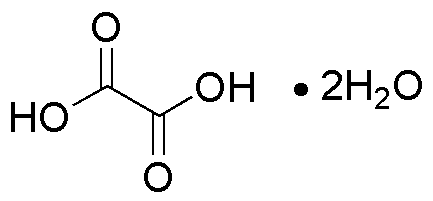Oxalic acid dihydrate is widely utilized in research focused on:
- Textile Industry: It serves as a bleaching agent, effectively removing stains and discoloration from fabrics, enhancing their appearance and longevity.
- Metal Cleaning: This compound is used in metal cleaning and polishing processes, particularly for removing rust and tarnish from metals like brass and copper.
- Food Industry: In controlled amounts, it acts as a food additive, contributing to flavor and preservation in various products, such as certain fruits and vegetables.
- Laboratory Applications: It is a key reagent in analytical chemistry, particularly in titrations and as a standard for calibrating equipment due to its known purity and stability.
- Pharmaceuticals: Oxalic acid dihydrate is used in the synthesis of various pharmaceutical compounds, providing a versatile building block for drug development.
General Information
Properties
Safety and Regulations
Applications
Oxalic acid dihydrate is widely utilized in research focused on:
- Textile Industry: It serves as a bleaching agent, effectively removing stains and discoloration from fabrics, enhancing their appearance and longevity.
- Metal Cleaning: This compound is used in metal cleaning and polishing processes, particularly for removing rust and tarnish from metals like brass and copper.
- Food Industry: In controlled amounts, it acts as a food additive, contributing to flavor and preservation in various products, such as certain fruits and vegetables.
- Laboratory Applications: It is a key reagent in analytical chemistry, particularly in titrations and as a standard for calibrating equipment due to its known purity and stability.
- Pharmaceuticals: Oxalic acid dihydrate is used in the synthesis of various pharmaceutical compounds, providing a versatile building block for drug development.
Documents
Safety Data Sheets (SDS)
The SDS provides comprehensive safety information on handling, storage, and disposal of the product.
Product Specification (PS)
The PS provides a comprehensive breakdown of the product’s properties, including chemical composition, physical state, purity, and storage requirements. It also details acceptable quality ranges and the product's intended applications.
Certificates of Analysis (COA)
Search for Certificates of Analysis (COA) by entering the products Lot Number. Lot and Batch Numbers can be found on a product’s label following the words ‘Lot’ or ‘Batch’.
*Catalog Number
*Lot Number
Certificates Of Origin (COO)
This COO confirms the country where the product was manufactured, and also details the materials and components used in it and whether it is derived from natural, synthetic, or other specific sources. This certificate may be required for customs, trade, and regulatory compliance.
*Catalog Number
*Lot Number
Safety Data Sheets (SDS)
The SDS provides comprehensive safety information on handling, storage, and disposal of the product.
DownloadProduct Specification (PS)
The PS provides a comprehensive breakdown of the product’s properties, including chemical composition, physical state, purity, and storage requirements. It also details acceptable quality ranges and the product's intended applications.
DownloadCertificates of Analysis (COA)
Search for Certificates of Analysis (COA) by entering the products Lot Number. Lot and Batch Numbers can be found on a product’s label following the words ‘Lot’ or ‘Batch’.
*Catalog Number
*Lot Number
Certificates Of Origin (COO)
This COO confirms the country where the product was manufactured, and also details the materials and components used in it and whether it is derived from natural, synthetic, or other specific sources. This certificate may be required for customs, trade, and regulatory compliance.


